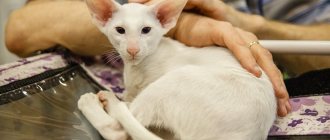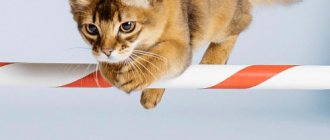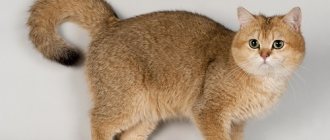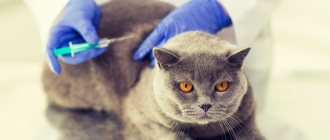How cat shows are held – 3
Registration for an exhibition, distribution of cats by exhibition classes
To participate in a cat exhibition, you need to find in the schedule of exhibitions using the WCF system the one that suits you by date and location. Club organizer m.b. any, but the exhibition must be held according to the WCF system. If you are already a member of any club, just in case, check with the head of your club whether your cat’s grades and titles for this exhibition will be counted. Then you need to submit a preliminary application for the exhibition and pay the exhibitor fee. At most exhibitions, registration is only preliminary.
To participate in exhibitions, all cats are divided into breed groups, then by breed, by color, and by exhibition class. Cats belonging to the same breed, color, gender and show class are compared with each other. Thus, competition and comparison for ratings and titles at the exhibition takes place between animals of the same breed, the same color, the same exhibition class, and the same sex. Division into colors - classes - sex exists in every breed. The difference is that some breeds can have many colors (PER, BRI, ORI, MCO), while others have fewer or even one (RUS - blue, BOM - black). Groups of breeds and breeds that belong to them:
• Longhair group (LH, LH): PER
• Semi-longhair group (SLH, SLH): SIB, MCO, NFO, RAG, NEV, SBI, ТUA, SOM, KBL, BLH, SFL
• Shorthair group (KS, SH): ABY, BEN, BRI, BUR, EUR, RUS, SFS, SCS, SIN, EUR, KBS, CRX, DRX, SPH, EXO
• Siamese-Oriental group (SO, SOSH): MBT, ORI, SIA, PBD, THA
At some exhibitions, a fifth group is introduced - hairless cats (if there are more than 15 representatives of the breeds at the exhibition: Canadian Sphynx, Don Sphynx and Peterbald). Exhibition classes: • a litter of three kittens aged from 10 weeks to 3 months without a mother cat – this is Litter class • a kitten from 3 to 6 months – kitten class (Kitten) • a kitten from 6 to 10 months – junior class (Junior) • cats from 10 months and older are considered adults and compete in the open class (CAC) • champion class (CACIB) • international champion class (CAGCIB) • grand international champion class (CACE) • European champion class (CAGCE) • class big European champions (CACM)
Learn more about WCF exhibition classes >>>>>>
Based on requests from future exhibition participants, a catalog is compiled where cats are recorded in a certain order - by breed, color, show class and gender. Usually the exhibition catalog is prepared no later than a week before the exhibition. Therefore, if you want your pet’s name to be included in the catalog, then hurry up
This is especially important for cat owners. This is free advertising for your cat.
Each cat is assigned a specific number in the catalog under which it will participate in judging. This number will be indicated on her cage, diploma and evaluation sheet. Cats at an exhibition are placed in special exhibition cages, and an exhibition number is attached to the cage. The same number must be permanently attached to the owner's clothing so that judges and spectators can easily understand which cat they are seeing at the moment. To the exhibition page of KLK “Moscow” Schedule of cat shows according to the WCF system in Moscow and nearby cities
How are exhibitions held?
The event can last 2–3 days. Most often, exhibitions are organized in winter, since it is during this period that pets’ fur grows most quickly and can be seen in all its glory. You must arrive at the event one hour before the start. This is necessary in order to choose a suitable place and have time to show the animal to the doctor. If this is neglected, the organizers may remove the pet from the competition.
Main stages:
- Registration. Immediately upon arrival at the venue, you must give all documents to the organizer. After this, you should pick up the catalog and registration number. It is important to check the accuracy of all entered data.
- Veterinary control. After registration, you need to go to the doctor and spread a diaper on the table, where the pet should be placed. Most often, this is not required, since the surface is treated with antiseptics. After inspection, pick up a ticket, which cannot be thrown away.
- Accommodation. At the chosen location you need to place the cage, adjust the curtain and attach the registration number.
- Grade. After the judge calls the registration number, you need to take the cat in your arms and go to the examination table, placing the animal there. In this case, you should calmly stand aside and not interfere in the process. Sometimes this stage goes differently. A steward may come pick up the cat and take it to an expert. At the same time, it is important to sit still and not argue with management.
- Completion of the examination. At the end of the assessment process, a conclusion should be issued, and after the exhibition a diploma.
- Demonstration. Once the assessment part is completed, the animal can be placed in a cage. At the same time, everyone walks through the exhibition hall, looking at the cats. At this stage, it is important to explain to all guests of the event that they cannot touch the pet, but only watch.
A pet is allowed to the exhibition only if it has the necessary documents
Attention! The cat always catches the owner’s mood, so during the event you need to be as nervous as possible. Otherwise, the pet will behave fearfully or aggressively, which may not please the expert.
Once I was at a cat show as a guest (so to speak, an outside observer). I really enjoyed the event, but I just felt sorry for the pets, who, apparently, were uncomfortable in the cages. Some of them were sleeping, and some were playing with their relatives. All the cages were well-groomed, as were the pets themselves. Cats could be photographed, but without flash. Right at the exhibition you can purchase any purebred animal for a decent amount. However, there is no risk that you could be deceived. Buying a cat at an exhibition is the best option, according to the expert, although you will have to overpay a certain amount.
Record
So, how to get to a cat show? The easiest way is to contact the breeder from whom you purchased the kitten. If this is not possible, you need to call your local club or go to the WCF website to find out the schedule. You can choose another system, but most exhibitions in Russia and neighboring countries are held by WCF - World Cat Federation.
Now all that remains is to choose a date, not forgetting to clarify the details: the address of the pavilion, the start time, whether a tent will be needed for the cat exhibition or whether the organizers will provide cages for the participants to house the animals, how the fee can be paid. Usually the organizers provide the account number to which the transfer needs to be made. In addition, you can pay for participation in a local club. If you are interested in how much a cat show costs, check this point in advance. As a rule, the amount ranges from 800 to 2000 rubles, depending on the rank of the event. Typically, the exhibitor fee can be paid directly on the day of the exhibition, which should also be inquired about in advance.
Since only registered competitors can participate in the cat show, you will need to provide the organizers with some information: age, breed, gender, color, etc. If you communicate by phone, the operator will ask all the necessary questions. If you fill out an application in writing, simply check the pedigree and enter the data as it is written in the document, without distorting the nickname, color, etc. Now your pet is registered, his and your data will be included in the catalog. In addition to personal data, at the registration stage you need to select a class. According to the WCF system, there are more than twenty classes: kittens, juniors, open class, international champion and so on. If this is your first cat show, and your pet is already ten months old, you need to enroll in an open class. This means that the cat will compete for the title “Champion” with other animals of the same breed and sex, but she can only get it (close) by receiving three CACs from three different experts at three different exhibitions (CAC - Candidate for Champion).
In addition to the examination, you can sign up for a special breed show and ring. Monobreed is an open selection of the best animals within one breed. The ring is an open judging where an expert selects the ten best animals in the exhibition, regardless of gender and breed, and distributes ten places among them. Titles at cat shows can only be obtained by passing an examination in your class, and victory in the ring or in a special breed is a flattering title, prestige, advertising, valuable gifts and simply bright emotions, comparable only to participation in Beste (which will be discussed below ).
Documentation
At 1.5 months I draw up documents for the kittens. At this age, they need to undergo activating - this is the name of the examination of purebred animals, during which they determine which kittens are suitable for breeding, and which are better off just being a pet. I took special courses and now I can carry out activation myself.
If the owner does not have such qualifications, you can simply take the kittens to the cat breeder or to the felinological club: they will help you prepare the documents. Only official clubs have the right to do this. Each of them has several dozen catteries of different breeds attached to it.
The club officially registers the litter, and each kitten receives a birth certificate. All this costs an average of 500 RUR for all kittens, the examination is included in this amount. Those animals that are selected for breeding also receive a pedigree. We paid 1000-2000 RUR for its registration, depending on the club.
An example of metrics for a kitten, they look different in different clubs
How to behave at a cat show
Well, here it is, the cherished day “x” has finally arrived, you took the documents, everything you needed according to the list given above, and most importantly, you took your cat with you. You are full of enthusiasm and are in anticipation of the expected victory. We can wish you good luck and victory. But before we start congratulating you on them, you will need to show yourself on the positive side of your participation in the exhibition. Therefore, now we will tell you what you should do and how.
Registration of cat show participants
Your participation in the exhibition begins with your registration. To do this, go to the registration desk and receive the exhibition catalog and an envelope with a registration number. Please check that the information entered in these documents is correct. One mistake can cast doubt on the fact that your cat is the cat that is participating in the show. Therefore, be careful.
Veterinary control
Next to the receptionist's desk there is a veterinary control desk. Here you will need to provide the cat’s veterinary passport, a certificate from the veterinarian, and show the animal itself
Attention - you should not put a cat on a table that has not been treated with a disinfectant before you. If the veterinarian does not do this for some reason, bring this to his attention.
You have the right to refuse to risk the health of your animal. Although, some exhibitors in this case prefer to clean the table themselves or use a disposable diaper for inspection.
Choosing a seat in the hall
If you yourself have the opportunity to choose the location of your tent, choose, if possible, places not far from the judging tables and the ring, and make sure that there are no drafts or too noisy there. After this, you can lay out your things and begin to directly prepare the cat for participation in the exhibition and for judging.
Call to the judge's table
After the examination begins, expect to be called to the table. During the examination, watch yourself and the animal. Showing your dissatisfaction with anything or anyone is not worth it. Be prepared to also go through a comparison process if necessary.
Participation in additional events
All kinds of competitions, fashion shows and other entertainment programs should be considered for participation only if the animal does not experience discomfort from all this.
Winners Award
The most exciting moment is that if you have prepared correctly for the cat show, taken care of the healthy and attractive appearance of your pet, then it is likely that your cat’s name will appear on the list of winners. We sincerely wish this for you.
Video about the cat show:
Preparing cats for an exhibition - everything the owner needs to know
Preparing cats for an exhibition - everything the owner needs to know
They say that 90% of success is the ability to present yourself correctly. Fairly noted, and this aphorism applies not only to people, but also... to cats! Yes, yes, in order to win the most significant titles and awards at exhibitions, a pet needs to look and feel impeccable. And of course, a loving, caring owner will help him with this, who will spare no time and effort, because the result is worth it!
Step #1: Documents
So, first of all, the cat owner should think about all the formalities - correctly prepare a package of documents and comply with all the requirements. To participate in cat shows in Russia, the following veterinary requirements must be met: - The age of the exhibition participant must not be less than 3 months (for European Union countries - not younger than 4 months).
— Each animal must have a veterinary passport with notes on vaccinations and treatments against parasites, as well as a certificate from the state veterinary hospital, Form No. 1 or Form No. 4, which is issued on the basis of a veterinary passport and a clinical examination of the cat. The certificate indicates the owner’s information, as well as the sex, age, breed, color of the cat, information about vaccinations and other veterinary measures, the route and mode of transport. A clinical examination involves assessing the appearance, skin and coat, the absence of parasites (fleas, ear mites), the absence of pathological discharge from the eyes and nose, examination of the groin area, examination of the oral cavity.
— Diagnosis of fungal infections using a WUDA fluorescent lamp is also mandatory (many fungal infections, including ringworm, often do not give any visible clinical symptoms in the early stages, but are extremely contagious to other animals). A fluorescent lamp makes it possible to detect the presence of fungus; the affected fur in most cases gives off a bright phosphorescent glow of the hairs, and such an animal cannot be allowed to participate in the exhibition, so as not to put other competitors at risk.
— Often a stool test for helminths (worm eggs) is required.
— Each animal must have comprehensive vaccinations against viral infections (panleukopenia, rhinotracheitis, calicivirus) and vaccination against rabies, after which at least 30 days and no more than 12 months must pass.
For participants from the European Union and many Asian countries, mandatory microchipping is required - a special fiberglass capsule with a built-in microcircuit is inserted under the skin of the cat, containing all the data about a particular animal and its owner. This information can be read with a special scanner.
Step #2: Appearance
In addition to preparing documents, it is important to pay great attention to the appearance of the future contestant. If the cat will be exhibited, and you have ambitious plans for your pet to win honorary titles, then long before the start of the season you need to start preparing your pet for the exhibition. Otherwise, even if you use the services of a professional groomer on the eve of the event, the cat will not be able to look perfect enough to receive high marks from the judges.
If your pet belongs to long-haired or semi-long-haired breeds, you should start working on its appearance approximately 5-7 months before the exhibition, if the cat is short-haired - 3-4 months.
First, let's talk about the main points of professional exhibition training for cats, regardless of the length and type of coat.
Absolutely all cats need regular bathing using special professional products. Many pet owners mistakenly believe that washing their cat is completely unnecessary, but this is not true. Despite the fact that the cat is a very clean animal and thoroughly cleans its coat on its own, from time to time it still requires water treatments.
The frequency of washing depends on the length and thickness of the coat, as well as on the individual characteristics of each cat. For example, long-haired and semi-long-haired animals need to be bathed once every 10-14 days, short-haired animals - once every 2-4 weeks. Naked - once a week or more, depending on the time of year.
Cats' fur often becomes greasy to one degree or another; small particles of household dust stick to it like a magnet. In addition to an untidy appearance, this can cause various troubles (eczema, dermatitis, etc.). Therefore, an important point in regular care is degreasing with the help of special pastes and gels, which are applied to dry wool, rubbed in, and then washed off with warm water. After using such products, you must use a neutralizing shampoo from the same series.
The use of conditioners or conditioners should also be mandatory, since all degreasers dry out the skin. The amount of conditioner applied to the cat’s fur and skin must be selected strictly individually.
In winter, animal fur and skin need nourishment. In this case, it is important to use nourishing and moisturizing fortified sprays. When it comes to caring for a cat, it is also important to take into account the characteristics of a particular breed, type and length of fur.
Persian and exotic cats. An important point in preparing for exhibitions of cats of these breeds is eye care. Animals with a brachycephalic type of muzzle often have profuse lacrimation, which leaves unsightly brown tracks. It is quite difficult to wash them clean, which is why you need to constantly care for the area around the eyes, regardless of the exhibition period.
The second point regarding the care of Persian cats is grooming. When working with this type of coat on a daily basis, texturizing shampoo, blow-drying and a texturizing spray are used. Exhibition grooming is characterized by additional manipulations: for example, trimming (trimming or plucking unwanted hairs) on the face, ears and tip of the tail.
Semi-longhaired breeds (SLH). Grooming for this coat group is almost identical to that for long-haired Persian cats. There is a main difference - Persian cats have fur and undercoat that are as long and voluminous as possible, but in the LDS group, only the undercoat, frill area, panties and tail are thick and voluminous, but the outer coat should be elastic, elastic and glossy. Therefore, during exhibition grooming, texturizing shampoos and sprays should be used specifically for semi-longhaired breeds.
Short-haired breeds (SH). Regular care for these cats is the same as for all others, but exhibition preparation requires additional knowledge and skills. Within the group of shorthaired cats, there are differences in coat texture. Some have a thick, uniform, dense undercoat (British, Scottish), others do not have it at all (Burmese, Bombay, American Shorthair, Bengal). In the first case, it is necessary to use additional products that add volume (both shampoos and sprays), and also be sure to do styling with a hairdryer, and in the second case, on the contrary, you need glossy polishing agents that allow the coat to fit tightly to the body.
Rexes (cats with curly hair). It is worth talking about these breeds separately. In addition to the basic stages of preparation, when caring for them, it is necessary to use special products for styling curls and ringlets.
Naked cats. These cat breeds also require regular skin care. Due to the presence of an excessive number of folds and increased sebum secretion, they need to be bathed once a week or more often. Degreasing pastes and shampoos, as well as nourishing hypoallergenic shampoos, are used. During the summer, sunscreen should be used if the cat has access to open sunlight.
Step #3: Psychological preparation
Of course, it is very important that the cat feels comfortable in an unfamiliar atmosphere. To do this, she must be accustomed to visiting crowded places from an early age (from 3-4 months), doing this regularly (1-2 times a month), so that already as a kitten she remembers what an exhibition is. To attend the first event in a kitten’s life, it is better to choose not the largest one (with the participation of no more than 100-150 cats).
It should be understood that a small creature that begins its exhibition career at the age of 3-4 months does not need the presence of a mother cat at all. This is already a psychologically developed, mature, independent personality, for whom the breeder or new owner plays the role of both mother and nanny.
At the same time, it is very difficult to bring, for example, a two-year-old cat to an exhibition that has never seen other animals or a large number of people. Most likely, such a cat will be nervous, hiss and may try to hide or run away from the ring. Thus, she, of course, will not be able to achieve high results at the exhibition. And no sedative drops, injections or pills will help here. That is why many professional breeders exhibit large numbers of not only adult animals, but also kittens.
Step No. 4: Exhibition space
Without a doubt, it is worth thinking in advance, and, if this is your first exhibition, then also consulting with more experienced colleagues about what your cat’s place at the exhibition should look like and what is needed for its equipment.
You must take the following set of things with you to the exhibition:
• Exhibition cage-tent with closing curtains; • Litter; • Toilet and filler; • Two bowls, food and water; • Toys; • Combs, cosmetics, nail clipper.
I would like to emphasize that you need to buy the exhibition cage in advance - bring it home, disassemble it, put a rug and toys in it, and place it in an open area for the kitten to access. Only in this case, even during the first visit to the exhibition, the risk of developing stress in a cat is minimized - a familiar tent, familiar toys, bedding that smells like a cozy home... I especially draw attention to - never use other people's tent cages! All accessories should be yours!
Step #5: Force Majeure
When going to an exhibition, you need to be prepared for a variety of troubles or incidents that may happen to your cat. For example, a kitten flew in from the other end of Russia and suddenly there was an accident (he crap himself on the way). You need 10-30 minutes to wash and dry your pet's bottom. In order to avoid such unforeseen situations or eliminate them in time, you should always have a hairdryer, combs, detergents, towels and toilet paper with you.
At some shows, judges may empathize with you and delay judging until the cat is in order. But such a step forward is not possible everywhere - it depends on the format of the exhibitions: European or American ring. In the first case, it is much easier to postpone the judging, since one cat undergoes only one judging in one day, but in the second, depending on your luck. And the reason for this is not only the judges’ disposition towards your pet, but also the large number of participants and rings. Because of one cat, it is impossible to delay the judging of 200 animals, because often at the exhibition there are 5-7 rings operating simultaneously, in each of which 12-18 participants are judging at one time.
If you provide your handsome man with proper care, timely preparation and psychological support, then he will not be afraid of anything, but on the contrary, he will radiate confidence and beauty. And when an animal feels at its best, the others can’t help but notice it!
How to prepare a cat for participation in an exhibition
Exhibition grooming
Depending on what breed your cat is - long-haired, short-haired, or has no fur at all, the requirements for its show grooming depend. So, for example, long-haired cats need to be bathed and styled the day before in order for their fur to look well-groomed and neat.
It is better to wash short-haired cats a week before the exhibition, since washing the day before will give the cat's fur excessive softness, and it will not look thick and plush, which is very important, for example, for the British
Cosmetical tools
Some cat owners, preparing them for such an important event, do not limit themselves to using ordinary cosmetics to care for the animal’s fur, and try to decorate it with special tint and tinting powders and tinting balms. I would like to say right away that this is not worth doing, because if the condition of the animal’s fur leaves much to be desired, then you will not correct the situation in one go, and not a single such remedy will help you with this. But the judges may notice your excessive zeal and for this they may disqualify the animal or deduct a point from it. So you should not use any tinting of the coat, cutting for thickness or tinting powder to give the original shade and shine.
Hygiene of a cat participating in an exhibition
Your cat should go to the exhibition with clean ears, trimmed claws (use special scissors - nail clippers) and washed hair. By the way, it’s not worth experimenting with new cosmetics and shampoos on the eve of exhibitions. Since you are unlikely to have time to wash the animal. About how to properly clean up a cat and how to care for it in its daily life - read about all this here.
Preparing for the event
To get everything done, you need to start preparing several months in advance. The necessary equipment will be required that will be important for participation in the exhibition, and the animal should also be brought into proper appearance. Proper nutrition before the event plays an important role, so you need to take care of your pet’s diet in advance.
What tools and equipment will be needed?
What you need to prepare in advance:
- a metal cage with curtains - it is important to pay attention to the design, as this is an additional point in the competition;
- bedding - it is best to give preference to dense and natural material;
- tray - the deeper the cat litter, the more convenient it will be at the event;
- toilet filler - give preference to the desired one that neutralizes odors and absorbs urine well;
- two bowls - it is recommended to buy small metal or ceramic options;
- food and water;
- toys - no more than 2-3 are enough;
- antiseptic wipes - will be needed to disinfect hands and tables;
- disinfector - you need to purchase the smallest volume and an additional rag;
- comb.
Before the event, it is important to purchase a metal cat cage
Additionally, it is recommended to take care of special bags where feces are disposed of, because the cat may go to the toilet more than once during the event.
Appearance of the animal
The first thing you need to do a week before the exhibition is to bathe your pet. In this case, it is advisable to use a balm during the procedure, which will improve the appearance of the coat. It is best to comb your pet immediately before the event. If you do this in advance, the wool may mat again. During combing, it is important to remove all tangles, since their presence is unacceptable.
It is recommended to brush your pet thoroughly before the event.
Ear cleaning should also be done the night before the event if necessary. To do this, you need to carefully examine your pet's hearing aid. It is best to bend the auricle and, if there is visible dirt, moisten a cotton pad in saline solution and carefully remove the wax. You can also use a cotton swab, but under no circumstances should you push it deep into the ear canal.
Requirements for the appearance of a pet for admission to the exhibition:
- absence of fleas and dirt on the coat;
- clean eyes, nose, ears and area under the tail;
- cut transparent tips of nails;
- absence of acne and other inflammatory processes on the skin.
In order to increase the chances of getting the highest score, you can also brush your pet’s teeth immediately before the event, especially if they have yellow plaque on them.
Nutrition rules
The day before the exhibition, you can feed your pet as usual. There are no dietary restrictions. However, you should not feed your cat just a few hours before leaving for the event. This can be done immediately after the exhibition ends. If the event lasts a long time, then you can give a little food during it.
It is not recommended to overfeed a cat on the eve of an event.
The day before, it is advisable not to give the animal anything that can cause diarrhea, so it is better to exclude dairy products from the diet for a while. As for water, the animal should drink as much as it wants. In this case, there should be no prohibitions, since the pet may be thirsty due to severe stress.
Attention! If you suspect a cat has a digestive disorder, it is important to show it to a veterinarian in a timely manner, who will prescribe medication and prevent incidents from occurring during the exhibition.
How to prepare your pet for an event - video
Why are domus exhibitions needed?
Organizers of outbred cat exhibitions have several objectives. The first of them, and probably the main one, is the promotion of kind attitude towards animals and the education of responsibility and care towards them.
Cat shows are now held in almost every city.
The second goal is to bridge the gap that has formed over the years between owners of purebred and mongrel cats, despite the fact that both share a love for cats.
It must be said that owners of purebred animals also come with pleasure to such events (albeit as spectators), because they understand that outbred cats are no less beautiful than purebred ones.
What types of cat shows are there?
If you are a happy cat owner, the animal has all the documents necessary for a cat, and you are eager to take part in the exhibition, then you will be interested to know that exhibitions differ from each other in exhibition systems and judging options. So, there are European and American options for judging, and now we will talk in detail about each of them.
European version of judging
In this case, the cat owner brings his animal participating in the cat show to the expert’s table. And, in the presence of the owner and his assistant, he evaluates the animal according to recognized breed standards. All data is entered into special assessment sheets. In parallel with this, the expert notes the best representatives of the breed in his protocol, and at the end of the exhibition day, by voting, the best cat or cat is selected, which best corresponds to the description and specifics of its breed. This is how the MFA and FIFA systems work...
American version of judging
In this case, the animal is assessed in the ring. Every ten cats are placed in exhibition cages and an expert evaluates them one by one, recording the data on evaluation sheets. True, instead of such assessment sheets in the American version, it is customary to use assessment ribonnes, the role of which can be played by a ribbon, which, depending on its color, indicates one or another assessment. The best representatives of the breed participate in the final ring and places are distributed between them depending on their suitability for the breed. This is the system used by SFA, TISA, and UIS.
How can a cat get a championship title?
It is noteworthy that based on the results of several exhibitions and based on expert assessments, the animal receives a title. True, each system has its own features for calculating such points and rules for assigning titles. So, for example, in WCF your animal needs to receive 3 marks at each stage. The initial title is champion, then international champion, then grand international champion, etc.
Requirements for the appearance of a cat
Requirements vary depending on the breed, but there are a number of general provisions that apply to all or almost all breeds:
- condition – the physical form of the cat must be excellent, the same applies to health;
- correspondence of parameters – the physical parameters of the “competitor” must correspond to the characteristics of the declared breed;
- cleanliness – the animal’s fur must be in impeccable condition, absolutely clean and trimmed in a certain way;
- temperament – a pet needs to have a balanced character, react calmly to strangers, other animals, strong odors, bright lights and loud sounds. A stable disposition greatly facilitates the work of the judge and, thus, indirectly increases the animal's scores;
- The cat's movements should demonstrate the grace and elegance characteristic of the species.
Reasons for disqualification or exclusion from competition:
- dirty wool;
- presence of parasites;
- refusal of veterinary examination;
- obvious traces of aggressive cosmetic treatment;
- wool dyeing;
- excessive use of powder;
- the presence of tangles;
- dirty ears;
- obvious physical defects.
How can I find out about the location of the exhibition?
In this regard, owners of domuses (this is what felinologists call cats without a pedigree) are very lucky. Unlike owners of purebred cats, they don’t have to bother with choosing a judging system, an expert, a felinological organization and other issues that are quite difficult for a layman to understand. All you need to do is find out the schedule of exhibitions, which can be done at your local felinological club or on the Internet. Then you need to call the organizers of the exhibition and ask whether applications from participants are accepted for the “domestic cat” class. A class is a group of cats that are similar in one way or another, so the exhibition will include classes such as kittens, breeders, purebred castrati and others.
Sometimes local clubs organize exhibitions dedicated only to outbred cats, which attract a fairly large number of participants and spectators. But, unfortunately, such events have recently become much more rare.
How to prepare an animal for an exhibition?
The first thing you should pay attention to is that the pet is as healthy and non-aggressive as possible. If a cat has bad breath, ears clogged with wax, or eyes running, then most likely she will simply not be allowed to participate at all.
In addition, the cat needs to be bathed, its claws filed and its ears cleaned.
If the cat has long hair, it should not only be bathed, but also combed on the eve of the exhibition so that its soft hairs do not become tangled. As for short-haired cats, they are bathed about a week before the day of the exhibition so that the coat has time to restore its texture, luster and gloss.
Exhibitions are held to show the beauty and diversity of outbred cats.
It can be helpful to look at your cat and think about what breed it resembles. Having determined the similarities, it is worth going to a website dedicated to this breed, where you can learn how to prepare a cat with this type of coat.
the washing up
Preparing for a cat show begins with bathing, but first you need to:
- comb with a sparse comb to rid the cover of dead hairs;
- trim claws;
- clean the inside of the ears;
- if the standard allows, pluck the hair on the ears from above;
- Place cotton balls in your ears.
When bathing, the cat should have support under its feet.
Washing takes place in 5 stages:
- Using products for deep cleaning of fur, thoroughly soap the animal. Particular attention is paid to the locations of the glands - behind the ears, under the tail, paws, pants. Light wool is bleached with special means, keeping them on the cover for 3-5 minutes. Rinse thoroughly, adding vinegar (4 tbsp per 10 liters) or citric acid (1 tsp per 1 liter).
- Another soaping with a degreasing shampoo is combined with combing. A wide-toothed metal comb will come in handy. Lather your hair with a sponge or toothbrush. Rinse the animal with plenty of water.
- Lathering with exhibition shampoo, special attention to the face and paws. Rinse.
- Lathering with tinted shampoo, which will add brightness and shine to the coat. Leave for 10-15 minutes and wash off.
- For volume, the wool is treated with conditioner and styling gel. Then you need to rinse the cat thoroughly
Bringing beauty
Whether it's an international cat show or a local event, your pet should sparkle with purity! We brush our teeth at least three days in advance so that there are no traces of irritation on the gums. We remove crusts from the nose, wax from the ears, and clean the eyes. We cut and file the claws. We wash under the tail until shiny. There should be no traces of parasites or dandruff in the fur. We cut off the broken whiskers, soften the paw pads with rich cream, remove black spots on the chin with a scrub, dry the greasy collar and base of the tail with powder - every little detail is important.
Since you need to prepare your cat for an exhibition one hundred percent, be sure to find out exactly how your pet’s coat should look. To do this, call the breeder or visit the breed forum. In general: long-haired cats are bathed the day before the event, short-haired cats a week before. Long-haired cats should have fluffy, airy hair without waves (if this is not a feature of the breed). Short-haired cats have a smooth, shiny coat, with no bristling hairs.
Preparing the appearance
Grooming is an important element of preparing a cat for an exhibition; it emphasizes the thoroughbred and beauty of the animal.
Taking care of your pet’s appearance begins not a day or two before the event, but from the birth of the kitten. The cat is washed occasionally (or when it is very dirty), but depending on the length of the coat, it is combed 1-2 times a week. Regularly clean the animal's ears and eyes, trim its claws, and remove tartar.
Before the exhibition, all these procedures are mandatory in full; they must demonstrate the merits of the pet in the best possible way.
Show temperament
Before you think about how to get to a cat show, you should make sure your pet is ready to visit such a crowded place. There is no point in wasting time on grooming and travel if the cat is shy, aggressive and has never left the apartment. The socialization of the future starlet begins from a very early age. An unsociable, shy cat, surrounded by a crowd, a cacophony of alien smells and deafening sounds, will experience extreme stress. How can you participate in a cat show if the contestant hisses, scratches the expert and bristles her fur from fear? Most likely, such a cat will be disqualified or given the lowest score. As a result, money and time are wasted, the cat is stressed, and the owner is upset.
If a pet cannot tolerate the touch of others, does not tolerate a stranger touching its head, looking into its ears and eyes, touching its tail and paws, there is no need to subject its nervous system to such a load. There are online cat shows - a kind of amateur beauty contests for those owners who, for whatever reason, do not want to burden themselves with long trips. Of course, the titles and titles awarded to competitors are not recognized by official feline systems. But because of this fact, an online cat show does not lose its attractiveness for amateurs, because positive emotions do not depend on the presence or absence of a stamped diploma.
How to solve a cat's stress problem
To relieve your pet of stress, use the new drug Express Calm. The active ingredient of Express Uspokoina - trazodone succinate - is a unique patented development of NVP Astrapharm. It helps accumulate serotonin (the hormone of joy) and suppresses the manifestation of fear and anxiety in the following stressful situations:
- during a trip;
- during loud sounds (fireworks, repairs);
- when visiting a veterinarian or groomer;
- when moving to a new home;
- when parting with the owner;
- when a new family member arrives.
Upon arrival at the place
The first step is to inform the secretariat that you have arrived. To do this you need to register. Take all the documents and get in line. The secretary will check the data and give you the exhibition catalog and two plates with the number. The catalog contains information about the participants and the cat show program. Check all the data: if an error is found, notify the secretary as soon as possible and fill out a special form, otherwise the resulting score will be invalid.
If it is a large international cat show, the boxes provided by the organizers may already be numbered, then all you have to do is find your place. If not, you can choose any table you like. It is advisable that this be a place close to the expert’s table, not in a draft, not under air conditioning. You can remove the cage and set up your own tent. Now it's time to go through veterinary control.
Take with you all the documents, the cat in a carrier and a disposable diaper, which you need to lay on the table before placing the cat on it. The veterinarian will examine your pet and, if everything is in order, will issue you a veterinary certificate. The doctor will not allow an animal to be examined that appears to be unhealthy, an aggressive, deaf or overly timid cat, or a pregnant or lactating pet. In addition, cats with the phalanges of their toes (claws) removed are not allowed for examination.
Now you can settle in. Place the cat in the tent, attach one of the plates with a number to the box (the second is attached to the owner’s chest), pour the cat a drink, and decorate the box. Do not go far from the tent: when the examination begins, the steward will call you personally or your number will be announced over the speakerphone.
What to take with you to the exhibition
Money for the exhibition. Vet passport and your passport. Tent for cats. Disposable diapers. Wipes are dry and wet. Garbage bags. Odor Killer. Grooming products (comb, powder, antistatic agents, cotton wool, eye wash, cotton swabs, shampoo, hair dryer, etc.) Nail clipper. Harness. Tray and filler. Cat food, drinking water. Disinfectant. Cat toys. In a tent, a house or bedding. A copy of the pedigree. A plate on the cage with the cat's data. Vet kit: hydrogen peroxide, bandage, scissors, adhesive plaster, Bayun cat, Sofradex eye drops, Fosprenil type antiviral (drop into the nose), Gamavit, activated charcoal, Loka ringer.
What cats can take part in Domus exhibitions?
Any cat that is 10 months old or older can become a competitor. True, you need to meet some more requirements, which are similar to those that apply to purebred cats. First of all, the animal should not have any health problems. Secondly, the animal must be visibly well-groomed and in good shape. Pregnant and lactating cats, as well as animals whose claws have been surgically removed, are not allowed to participate in the exhibition, as well as cats with excessive aggression.
At every show there is a class of domestic cats called Household Pet (HHP), or simply PET.
However, there is one significant difference: all outbred cats, without exception, must be sterilized or neutered. And this requirement is not at all a whim of the organizers. This is an elementary felinological responsibility, which requires that the breeding of animals be carried out by professionals who have undergone special training.
Physical Compliance
Any preparation for a cat show makes sense if the animal has no physical defects and meets breed standards. Each breed has its own beauty parameters.
Health
The health of your pet is of great importance; for this, on the eve of exhibition events, you should conduct a veterinary examination and obtain a certificate:
- form 1 - for an exhibition in another city;
- Form 4 - for an event in your city.
A cat that the owner intends to demonstrate at an exhibition must be treated for fleas and helminths, which is noted in the veterinary passport.
There must also be a record of vaccinations:
- against rabies;
- chlamydia;
- leukemia;
- panleukopenia;
- rhinotracheitis;
- calicivirus.
Preparing for a cat show includes taking medications to relieve sexual arousal.
Nutrition
To ensure that the animal looks healthy, but not fat, and has a shiny coat, special attention is paid to nutrition a month before the exhibition.
2-3 weeks before the exhibition, the pet can be switched to food with a high protein content or to special food for pregnant cats or kittens. You should first make sure that the new food will not cause allergies in the animal.
If the pet has gained excess weight, it is transferred to a fasting diet 5-6 weeks before the event.
Although premium food contains a vitamin supplement, to improve appearance 3-4 weeks before the exhibition you can additionally introduce the following into the diet:
- seaweed - in some cases it brightens the color and color of the eyes;
- biotin and B vitamins - stimulate hair growth;
- carrots enhance the red color.
Important! 3-4 weeks before the exhibition, the cat should be encouraged to exercise.
Cat Show Systems
All cat exhibition systems are divided into 3 types:
- European
- American
- British
Each system differs in judging methods, show classes, titles and much more.
European system
The wcf system is one of the European ones, which is currently considered the most popular in Russia. It is known for the fact that its experts are relatively loyal to new breeds and recognize them quite quickly
In addition, according to the wcf system, the cat is accompanied by the owner throughout the entire exhibition, which, you see, is important for a pet. Score sheets and diplomas at such an event are issued only after the exhibition
European exhibition systems also include fife, ofa, farus, mfa, wacc.
American system
The American exhibition system is distinguished by the fact that experts do not evaluate cats on tables. There are rings where cats are described verbally. And instead of evaluation sheets, participants in such exhibitions are given ribbons called ribbons. According to the American version, systems such as tica, cfa, cff, icu, rui and wca work.
British system
The British system is not as popular as the European and American ones. There is only one system here - gccf, which evaluates cats sitting in cages.
conclusions
Today we talked about cat shows, and why they are held, what useful things you can learn from this event, how to prepare for it and how to prepare your cat for this important day. We also considered the basic rules of behavior during the exhibition. We hope that following our tips and tricks will help your cat get the reward it deserves.
Does your cat participate in exhibitions? What titles does she have? We are waiting for your comments and invite you to join the discussion of this topic in our VKontakte group...
We are waiting for your feedback and comments, join our VKontakte group!











